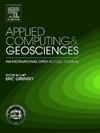建立相关等级和吨位分布模型的统计方法及其在矿产资源评价中的应用
IF 3.2
Q2 COMPUTER SCIENCE, INTERDISCIPLINARY APPLICATIONS
引用次数: 0
摘要
从已发表的报告汇编的矿物资源数据中存在品位和吨位之间的相关性,但在对未发现的矿物资源进行定量评价时并不总是处理这些相关性。未能考虑到相关的品位和吨位分布可能导致地质上不现实的评估结果。目前的软件工具可以独立地模拟未发现矿床的单变量矿石吨位和多变量资源品位。因此,分析人员被迫依靠特别的解决方案,通过以下方式将相关性问题最小化:1)创建具有限制标准的数据子集;2)截断品位和吨位分布;3)利用探索性数据分析检验模型的稳健性。虽然这些方法是实用的解决办法,但这里提出的统计解决办法提供了额外的选择,以解决用于矿产资源评估的品位和吨位数据之间的实际相关性。我们在R中提出了MapMark4软件包的修改版本,其中引入了两种用于建模品位和吨位分布的替代方案,其中包括一个考虑矿石吨位和金属品位之间相关性的多元解决方案,以及一个利用简单随机抽样的经验解决方案,该解决方案利用替换从输入数据中重现耦合的品位和吨位。我们为三个案例研究提供了包含矿石和金属的模拟,分别代表钨矽卡岩、科马铁矿含镍和沉积物含碳酸盐岩浆锌铅(密西西比河谷型)矿床。采用本文提出的方法可以产生定量的矿产资源评估结果,这些结果更接近地反映了在自然界中观察到的等级和吨位的经验分布,并扩大了这些工具对正在进行的关键矿产资源评估的适用性。本文章由计算机程序翻译,如有差异,请以英文原文为准。
Statistical approaches for modeling correlated grade and tonnage distributions and applications for mineral resource assessments
Correlations between grade and tonnage exist in mineral resource data compiled from published reports, but they are not always addressed during quantitative assessment of undiscovered mineral resources. Failure to account for correlated grade and tonnage distributions can result in geologically unrealistic assessment results. Current software tools simulate univariate ore tonnage and multivariate resource grades of undiscovered deposits independently. As a result, analysts are forced to rely on ad-hoc solutions to minimize the correlation issues by: 1) creating subsets of data with restricted criteria; 2) truncating grade and tonnage distributions; and 3) testing model robustness using exploratory data analysis. While these methods represent pragmatic solutions, the statistical solutions presented here provide additional options to address real correlations in grade and tonnage data used for mineral resource assessments. We present a modified version of the MapMark4 package in R that introduces two alternatives for modeling grade and tonnage distributions, consisting of a multivariate solution that accounts for correlations between ore tonnage and metal grades and an empirical solution that utilizes simple random sampling with replacement to reproduce coupled grades and tonnages from the input data. We present simulations for contained ore and metal for three case studies representing tungsten skarn, komatiite-hosted nickel, and sediment-hosted carbonate amagmatic zinc-lead (Mississippi Valley-type) deposits. Employing the methods presented here yields quantitative mineral resource assessment results that more closely reflect the empirical distributions of grades and tonnages observed in nature and expands the applicability of these tools for ongoing critical mineral resource assessments.
求助全文
通过发布文献求助,成功后即可免费获取论文全文。
去求助
来源期刊

Applied Computing and Geosciences
Computer Science-General Computer Science
CiteScore
5.50
自引率
0.00%
发文量
23
审稿时长
5 weeks
 求助内容:
求助内容: 应助结果提醒方式:
应助结果提醒方式:


